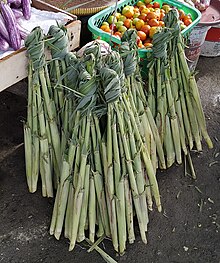| Saccharum edule | |
|---|---|

| |
| Saccharum edule at a market in Luwuk, Banggai, Central Sulawesi | |
| Scientific classification | |
| Kingdom: | Plantae |
| Clade: | Tracheophytes |
| Clade: | Angiosperms |
| Clade: | Monocots |
| Clade: | Commelinids |
| Order: | Poales |
| Family: | Poaceae |
| Subfamily: | Panicoideae |
| Genus: | Saccharum |
| Species: | S. edule
|
| Binomial name | |
| Saccharum edule | |
Saccharum edule is a species of sugarcane, that is a grass in the genus Saccharum with a fibrous stalk that is rich in sugar. It is cultivated in tropical climates in southeastern Asia. It has many common names which include duruka, tebu telor, PNG/Fiji asparagus, dule (Fiji), pitpit (Melanesia/New Guinea) and naviso.
The young, unopened flower heads of Saccharum edule are eaten raw, steamed, or toasted, and prepared in various ways in Southeastern Asia, including New Guinea, Fiji and certain island communities of Indonesia.[1][2]